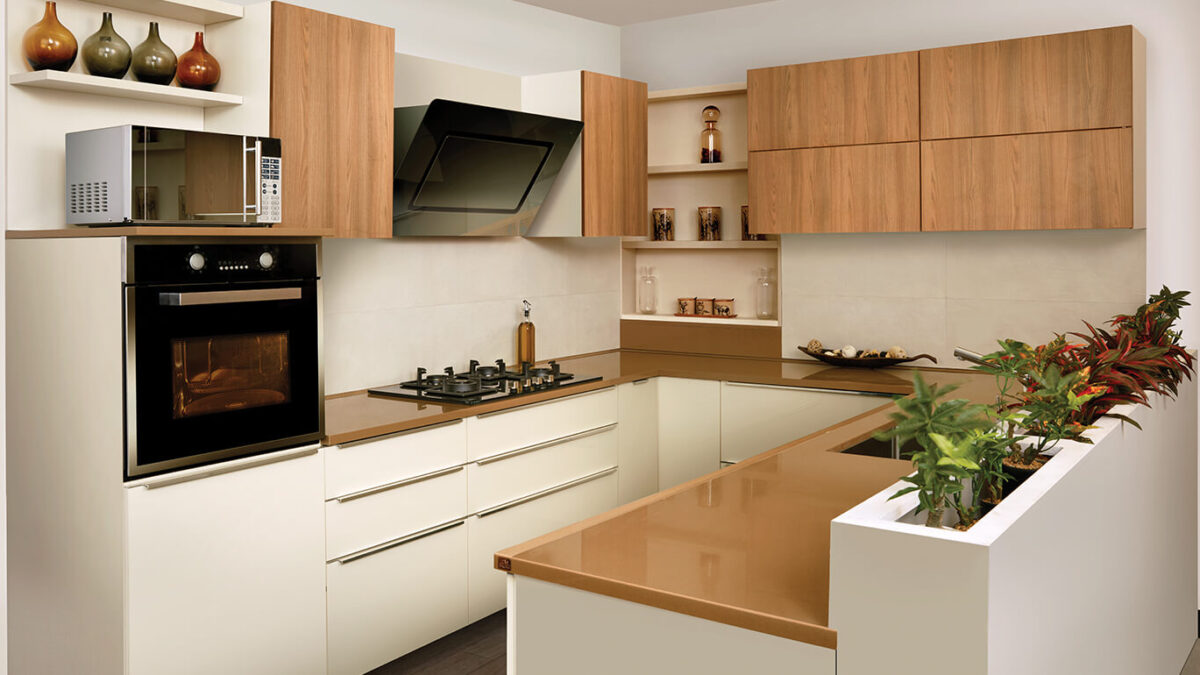
Discover the Harmony of Vastu Shastra: Transform Your Space and Life
June 5, 2024
Harmonizing Spaces: Applying Vastu Principles in Modern Architecture – 2025
October 29, 2025The kitchen is often considered the heart of the home, a place where nourishment and family bonding occur. According to Vastu Shastra, the ancient Indian science of architecture and design, the kitchen holds significant importance. You can create a space that promotes health, prosperity, and happiness by aligning the kitchen with Vastu principles. This comprehensive guide explores how to design and arrange your kitchen according to Vastu, ensuring a harmonious and positive environment.
Understanding Vastu Shastra
What is Vastu Shastra?
Vastu Shastra is a traditional Indian system that combines architecture, art, and science to design spaces that align with natural forces and cosmic energies. The primary goal of Vastu is to balance the five elements—earth, water, fire, air, and space—to create harmonious living and working environments.
Importance of the Kitchen in Vastu
In Vastu Shastra, the kitchen represents the fire element (Agni) and is crucial for health and prosperity. Proper placement and arrangement of the kitchen can enhance positive energy, while poor design can lead to imbalances and negative outcomes.
Ideal Location for the Kitchen
Directional Placement
According to Vastu, the ideal location for the kitchen is the southeast corner of the house. This direction is ruled by the fire element, making it the most suitable place for cooking. Alternatively, the northwest corner is the second-best option if the southeast is not available.
Southeast Corner
- Benefits: Aligns with the fire element, promoting health and well-being.
- Considerations: Ensure proper ventilation and natural light to balance the fire energy.
Northwest Corner
- Benefits: Controlled fire element, suitable for kitchens where the southeast direction is not possible.
- Considerations: Maintain cleanliness and avoid clutter to ensure positive energy flow.
Avoiding Inauspicious Directions
- Northeast Corner: Placing the kitchen here can disturb the water element, leading to health issues and financial problems.
- Southwest Corner: This direction is dominated by the earth element and can create conflicts and instability if used for the kitchen.
Layout and Design of the Kitchen
Position of the Cooking Stove
The stove is the most important element in the kitchen and should be placed in the southeast corner. When cooking, face east to harness positive energy. If the stove cannot be placed in the southeast, ensure that it faces the cook in a way that allows them to face east while cooking.
Placement of the Sink
The sink, representing the water element, should be placed in the northeast corner of the kitchen. This placement ensures a balance between the fire and water elements. If the northeast is not feasible, the north or east direction is also acceptable.
Position of Storage Units
Storage units for grains, utensils, and other kitchen items should be placed in the southern or western walls of the kitchen. This placement ensures stability and balance. Avoid placing heavy storage units in the northeast corner to prevent blocking positive energy.
Windows and Ventilation
Proper ventilation is crucial for maintaining positive energy in the kitchen. Ensure there are windows in the east or north walls to allow fresh air and natural light. An exhaust fan or chimney should be installed in the southeast direction to eliminate smoke and odors efficiently.
Colors and Materials in the Kitchen
Color Scheme
Colors play a significant role in Vastu Shastra. For the kitchen, choose colors that enhance the fire element while maintaining a harmonious balance.
Recommended Colors
- Yellow: Represents energy and positivity.
- Orange: Symbolizes warmth and enthusiasm.
- Red: Enhances the fire element, use in moderation.
- Green: Balances the energy and promotes freshness.
Colors to Avoid
- Black: Can attract negative energy.
- Dark Blue: May dampen the positive energy in the kitchen.
Materials
Selecting the right materials for countertops, cabinets, and flooring can influence the kitchen’s Vastu compliance.
- Granite: A durable and energy-stabilizing material for countertops.
- Wood: Natural and warm, ideal for cabinets and flooring.
- Ceramic Tiles: Easy to clean and maintain, suitable for backsplashes and flooring.
Appliances and Gadgets
Refrigerator Placement
The refrigerator should be placed in the southwest direction of the kitchen. This placement aligns with the earth element, ensuring stability and balance. Avoid placing the refrigerator in the northeast or southeast corners.
Microwave and Oven
These appliances represent the fire element and should be placed in the southeast direction. Ensure they are not adjacent to the sink or any water source to prevent energy conflicts.
Water Purifier
The water purifier, representing the water element, should be installed in the northeast or north direction of the kitchen. This placement ensures the purity and positive energy of water.
Maintaining a Vastu-Compliant Kitchen
Cleanliness and Organization
A clean and organized kitchen is essential for maintaining positive energy. Regularly clean countertops, appliances, and storage areas to prevent clutter and stagnant energy.
Fresh Ingredients
Using fresh ingredients in your cooking not only enhances the taste of your meals but also contributes to the positive energy in the kitchen. Keep fresh fruits, vegetables, and herbs easily accessible.
Sacred Symbols and Decor
Incorporating sacred symbols and decor elements can enhance the positive energy in the kitchen. Consider placing a small idol or picture of a deity in the kitchen to bless the space with divine energy. Avoid placing it above the stove or sink.
Common Vastu Remedies for Kitchen
Correcting Directional Imbalances
If your kitchen is not in the ideal Vastu direction, consider these remedies:
- Mirrors: Placing a mirror in the northeast corner can help balance the energy.
- Colors: Use Vastu-recommended colors to enhance the positive energy.
- Symbols: Sacred symbols or images can help mitigate negative effects.
Enhancing Energy Flow
- Plants: Indoor plants like basil (Tulsi) or mint can purify the air and enhance positive energy.
- Lighting: Ensure the kitchen is well-lit with natural and artificial light sources. Use bright, energy-efficient bulbs.
Integrating Modern Design with Vastu
Contemporary Kitchen Designs
Modern kitchens can seamlessly integrate Vastu principles without compromising on style. Choose sleek, minimalist designs that align with Vastu guidelines for placement and materials.
Smart Appliances
Incorporating smart appliances can enhance the functionality of your kitchen. Ensure their placement adheres to Vastu principles for optimal energy balance.
Case Studies: Vastu-Compliant Kitchens
Residential Success
A family struggling with frequent health issues and financial instability consulted a Vastu expert. By relocating their kitchen to the southeast corner and making adjustments to the layout and color scheme, they experienced significant improvements in health and financial stability within a few months.
Commercial Kitchen Transformation
A restaurant facing low customer turnout and high staff turnover sought Vastu consultation. Changes such as repositioning the stove, improving ventilation, and incorporating Vastu-recommended colors led to a more harmonious environment. This resulted in increased customer satisfaction and reduced staff turnover.
Conclusion
Designing your kitchen according to Vastu Shastra principles can significantly enhance the positive energy in your home, promoting health, prosperity, and happiness. By paying attention to the placement of key elements, choosing the right colors and materials, and maintaining cleanliness and organization, you can create a harmonious and balanced cooking space. Whether you are building a new kitchen or renovating an existing one, integrating Vastu principles can transform your kitchen into the heart of a harmonious home.
FAQs
1. Can Vastu principles be applied to small kitchens?
Yes, Vastu principles can be adapted to kitchens of all sizes. Focus on the placement of key elements like the stove, sink, and refrigerator, and choose Vastu-friendly colors and materials.
2. What if my kitchen is not in the ideal Vastu direction?
If your kitchen cannot be relocated, use Vastu remedies like mirrors, colors, and sacred symbols to balance the energy and mitigate negative effects.
3. How often should I consult a Vastu expert for my kitchen?
It is beneficial to consult a Vastu expert during the initial design or renovation phase. Regular consultations can help address any imbalances or issues that arise over time.
4. Are there specific Vastu guidelines for kitchen appliances?
Yes, Vastu provides guidelines for the placement of kitchen appliances. For example, the stove should be in the southeast direction, the refrigerator in the southwest, and the water purifier in the northeast or north.
5. Can Vastu principles be integrated with modern kitchen designs?
Absolutely! Modern kitchen designs can seamlessly incorporate Vastu principles. Focus on aligning key elements with Vastu guidelines while maintaining a contemporary and functional design.




